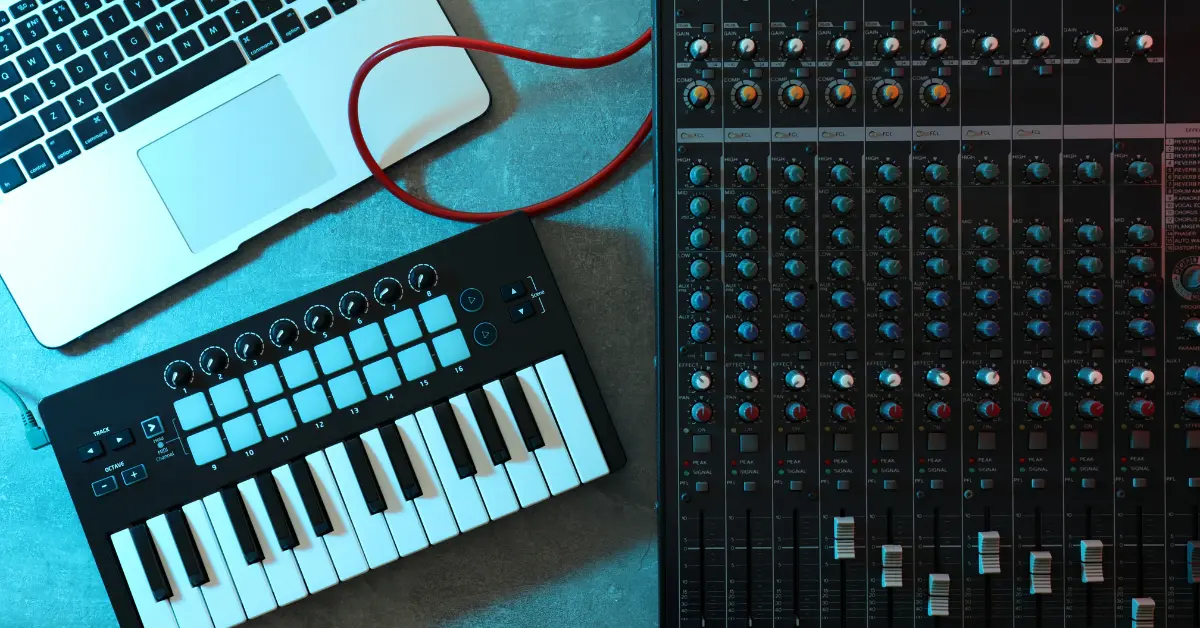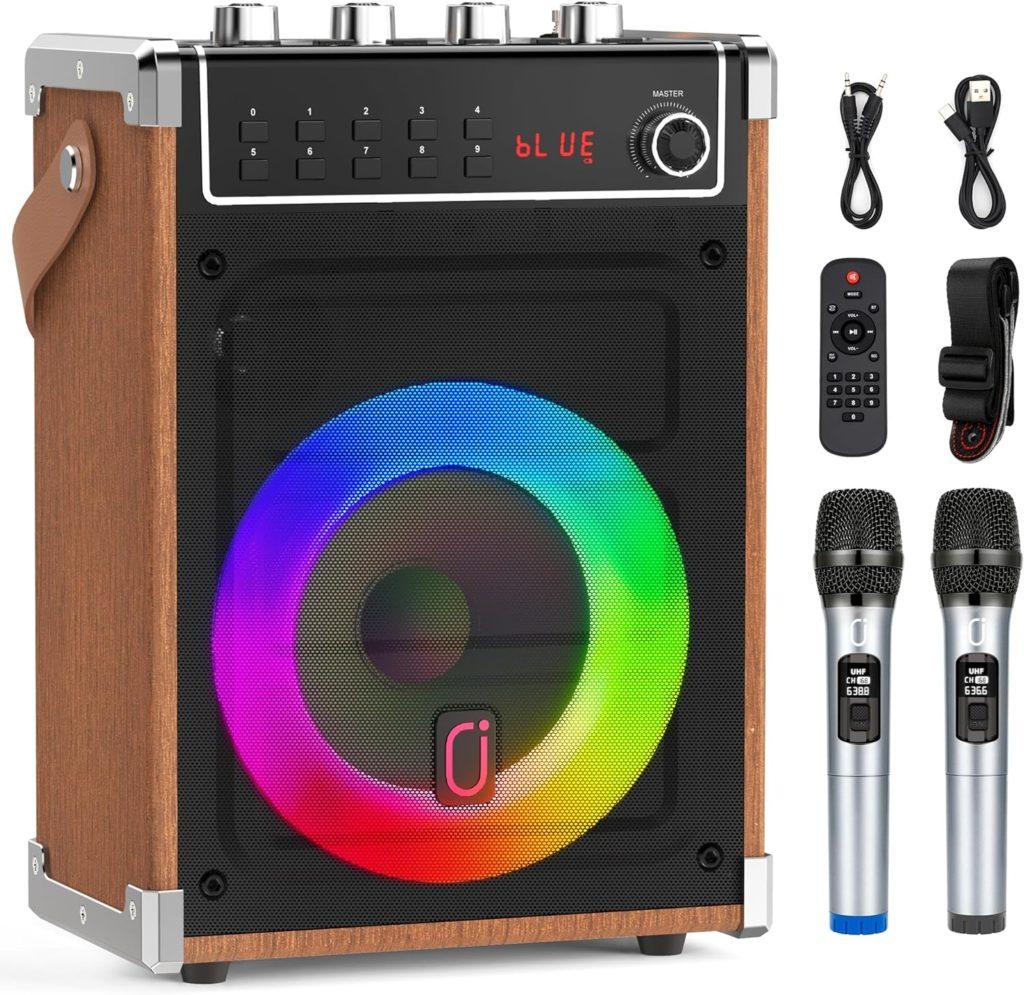
Ever tapped your foot to a pulsating beat, feeling the rhythm resonate in every cell of your being? That’s electronic music production.
Imagine for a moment you’re at an epic concert. You can almost taste the energy, feel it seeping into your soul as synthetic sounds envelop you. However, behind this magical experience lies countless hours spent crafting and fine-tuning each sound byte.
In this blog, we will discuss electronic music production. We’ll delve deep into how these sonic sorcerers use synthesizers and digital audio workstations (DAWs) to craft their captivating tracks.
What Is Electronic Music Production?
What is electronic music production? Unlike traditional music that relies on acoustic instruments and performance, electronic music is born from the blend of technology and creativity. It’s a genre made using electronic tools, computers, or synthesized sounds.
If you’ve ever moved to a beat at an EDM event or felt energized by some heavy hip-hop beats in your earphones, then you’re already acquainted with this type of music. However, creating these infectious tunes requires knowledge about digital audio workstations (DAWs), sound design principles, song arrangement techniques, and much more.
The Evolution of Electronic Music
In its early days during the mid-20th century, electronic music was produced primarily through analog synthesizers and tape manipulation. Today however it has grown significantly diverse both in terms of styles as well as production methods employed.
Ableton Live, FL Studio, Logic Pro X… if any of these names ring a bell then congratulations. You are already acquainted with some leading DAWs used for producing electronic tracks.
Making Weird Sounds Sound Good
An integral part of learning electronic music involves understanding how to generate sounds that fit within your creative vision. The beauty lies not just in crafting melodies but also in experimenting with white noise sweeps, kick drum thumps, or even alien-like bleeps.
Every successful producer starts off feeling eager yet overwhelmed. But there’s an entire process behind making electronic music, and once you get a hang of it, there will be no stopping.
Key Takeaway:
Dive into electronic music production, where creativity meets technology. Understand digital audio workstations (DAWs), sound design principles, and song arrangement to create infectious tunes.
From analog synthesizers to today’s diverse styles, there’s a world of sounds waiting for you. Remember, great music isn’t just about beats – it requires creativity, technical knowledge, and dedication.
The heart of any electronic music producer’s studio is the digital audio workstation (DAW). This software lets you record, edit, and mix tracks. Choosing the correct one can have a huge effect on your production process.
Choosing Your DAW
For those looking to create electronic music, there are several popular DAWs available such as Ableton Live, Logic Pro X, and FL Studio.
Ableton Live stands out due to its unique session view which aids live performances and encourages improvisation. It’s a favorite among DJs and producers who enjoy tweaking sounds during live sets.
If you’re into composing scores or producing hip-hop beats, then Logic Pro X might be up your alley. Its intuitive interface makes it easy to use while still offering depth for more advanced users.
FL Studio is known for its straightforward workflow that appeals particularly to beginners starting their journey in learning electronic music production.
A Note About Analog Synthesizers And Digital Instruments
Analog synthesizers like electric organs generate sounds from electrical voltages and circuits whereas digital instruments replicate analog synthesis behavior using binary code.
This fact may seem intimidating at first. But remember: great artists often start by mimicking others before developing their own style—so don’t feel discouraged if these concepts seem alien now.
Making The Right Choice For You
When deciding on your DAW or instrument of choice, consider factors such as price point along with how each tool aligns with your creative goals.
In the end, your tools should serve as an extension of your creative mind. Keep in mind that music production is not a race—it’s more like sculpting. Each artist has their own pace and style.
Don’t be scared to try out distinct DAWs until you locate the one that fits your needs.
Key Takeaway:
When it comes to electronic music production, selecting the right digital audio workstation (DAW) can really take your work up a notch. Ableton Live is a great choice for live sets, Logic Pro X shines in composing and hip-hop beats creation, while FL Studio offers an easy entry point.
And don’t hesitate to play around with analog synthesizers and digital instruments—sometimes copying leads to creating something unique. Keep in mind that finding the perfect tool isn’t always instant—it takes time.
The Art of Sound Design in Electronic Music Production
Sound design, the unsung hero of electronic music production, can make or break your track. It’s like a secret sauce that adds unique flavors to your sonic palette.
Analog Synthesis
Analog synthesis is creating sound through electrical signals. Imagine it as sculpting sounds from thin air. These handcrafted sounds often carry more weight and depth than their digital counterparts.
Think about the last time you were at a concert with an amazing bass drop – wasn’t it bone-rattling? That raw power comes from analog synthesis.
Effects Plugins
Ever wondered how producers transform ordinary tracks into mind-bending masterpieces? Enter effects plugins. They’re like spices for chefs – just sprinkle some reverb here and a dash of delay there.
Effects plugins, such as chorus or flanger, let you add dimensions to your track that weren’t there before. Suddenly, that simple melody line starts floating on clouds while the kick drum morphs into an alien heartbeat.
Finding Balance Between Clean And Dirty Sounds
Sometimes things need to get messy before they become beautiful. In sound design, this means mixing clean tones with ‘dirty’ ones to create complex textures.
One trick is using white noise sparingly. Too much will overpower other elements but when used correctly can give lifeless parts some edge.
Another technique is adding distortion or bit crushing to an otherwise clean sound, creating a rough diamond out of a polished stone.
Key Takeaway:
Sound design in electronic music production is like the secret sauce, bringing unique flavors to your tracks. Analog synthesis shapes sound from electrical signals for a deeper impact.
Use effects plugins to add new dimensions and mix clean with ‘dirty’ sounds for complex textures. Embrace unpredictability as part of exploration – it’s how you discover those golden sonic nuggets.
The Basics of Music Theory
The magic in electronic music production starts with understanding basic musical concepts like chord progressions and song structure. Why? Because they’re the building blocks that give your tracks a solid foundation.
Chord Progressions
You can think of chord progressions as the backbone of your track; they set its tone and mood. In electronic dance music (EDM), you’ll often hear four-chord loops that keep the energy high.
To master this element, you need to get familiar with major and minor scales. They are what we use to create chords for our progression. It might sound intimidating but fear not.
Once you start experimenting on your MIDI controllers or digital audio workstation (DAW), things will start making sense.
A cool thing about learning electronic music is finding new ways to break these rules after mastering them. Maybe try an unexpected key change in an EDM track or experiment with weird sounds by tweaking synth parameters.
Song Structure
Song structure gives us a roadmap for arranging our ideas into a cohesive whole – be it an emotional ballad or bouncy hip-hop beats. Common sections include intro, verse, chorus, bridge, breakdowns, and outro – each bringing something unique to the table.
If you’re feeling adventurous though – go off-road. Electronic music thrives on innovation.
Maybe kick drum-led choruses are your signature move? Or perhaps a white noise-filled breakdown? Experimentation can lead to the most exciting breakthroughs in music creation.
Electronic Instruments and MIDI Controllers
The world of electronic music is full of fascinating instruments, each offering unique sound textures. From synthesizers to drum machines, these tools are the lifeblood of a good music producer.
Electronic Instruments
Analog synthesizers have long been staples in producing electronic sounds. These beasts use electrical voltages to generate weird but captivating noises that can add flavor to your tracks. The legendary Moog synth or Roland’s TB-303 comes to mind when thinking about iconic analog synths.
But technology doesn’t stand still. We’ve seen digital counterparts emerge on the scene too. They replicate this behavior in binary code, providing near-perfect emulation at an affordable price point.
MIDI Controllers
A MIDI controller, meanwhile, is like a painter’s brush for producers – it helps you shape and mold your sonic canvas with precision and ease.
Some controllers come equipped with piano-style keys while others sport grid-like pads which are perfect for finger-drumming beats or triggering samples live. A notable example would be Akai Professional’s MPD218 featuring 16 pressure-sensitive drum pads.
Key Takeaway:
Dive into the world of electronic music with unique instruments like synthesizers and drum machines. Try out analog or digital synths, but don’t forget your MIDI controller – it’s your musical paintbrush.
Choose one that suits your style, whether you prefer piano keys or pad-based controls. Make sure it syncs well with your DAW for seamless music creation.
Mixing and Mastering
Have you ever wondered why some tracks just seem to hit differently? It’s not sorcery, yet it sure feels like it. The secret sauce is in the mixing and mastering process.
Mixing
Mixing is where your track starts to come alive. It’s about finding a balance between different elements, giving each instrument its own space in the sonic spectrum. This stage requires a keen ear for detail because every frequency counts.
In essence, think of mixing as arranging furniture in a room – everything needs its place without overcrowding or clashing with others.
Mastering
If mixing is arranging furniture then mastering would be adding those final touches that tie everything together beautifully. Mastering takes your balanced mix and polishes it into powerful music that can compete with commercial releases.
This step ensures consistent volume levels across all songs on an album while enhancing overall tonal balance.
Balancing Levels
Balancing levels might sound simple, but don’t let this fool you. From the kick drum’s thump to the whispery hi-hats, achieving harmony among various elements demands skillful tweaking using faders or automation tools within your DAW (Digital Audio Workstation).
When done right, you’ll notice how your track feels ‘fuller’ and each element shines without overpowering others. It’s like making a delicious meal where no single ingredient overshadows the rest.
Key Takeaway:
Mastering the art of mixing and mastering is essential in music production. Think of it like arranging a room, where every piece has its space. Mixing balances your track elements while mastering polishes them for commercial-grade sound.
Balancing levels within your DAW plays a crucial role here, letting each part shine without overshadowing others.
Finding Inspiration for Electronic Music Production
Every great music producer has a source of inspiration. But where does it come from? Well, in electronic music production, inspiration can strike from anywhere.
The World Around You:
It could be the rhythm of raindrops hitting your window or the hum of an air conditioner. Nature and urban life are teeming with sounds that can spark ideas for a new track. This practice not only helps you create unique soundscapes but also develops your ear for identifying musical elements in everyday sounds.
Listening to Other Genres:
Inspiration can be found when we venture outside our customary area. By exploring different genres like jazz, rock, or even classical music, you may stumble upon chords progressions or melodies that inspire an entirely new approach to making electronic tracks.
Mood Boards
Mood boards aren’t just for designers anymore. They’ve found their way into the music industry. Gather images that evoke certain emotions and use them as visual aids while producing electronic music.
Taking Advantage Of Music Theory
You don’t need to become Mozart overnight but having a good sense of basic music theory will help fuel creativity. Understanding chord progressions or song arrangement structures provides you with tools to experiment more effectively within your DAW (Digital Audio Workstation).
Dive Into The Past
Great music producers are often great students of history. Delving into the past, studying classic electronic dance tracks or old-school hip-hop beats can provide a wealth of inspiration. Understanding how these genres evolved and what made them successful could be the key to your next hit track.
Online Music Communities
Joining online communities where budding and experienced music producers share their work, is another excellent source of inspiration. Feedback from peers can give you fresh ideas while listening to others’ creations might ignite that creative spark.
Key Takeaway:
Draw inspiration for electronic music production from everyday sounds, explore different genres, and visual mood boards, and understand basic music theory.
Don’t forget to learn from the past and engage with online communities. Lastly, keep experimenting with your tools – every new discovery could be a stepping stone to your next hit track.
Advanced Techniques in Electronic Music Production
For those looking to create professional-level tracks, let’s look at some advanced techniques. Making electronic music that stands out requires a combination of skills, from understanding real instruments and their digital counterparts to crafting specific genre sounds like hip-hop or EDM.
Incorporating Real Instruments
Mixing organic elements with synthesized sounds can add depth and richness to your tracks. Whether you’re sampling an old vinyl record or recording live drums, native instruments are crucial tools for making this happen.
The key is in capturing those raw acoustic vibes and then creatively blending them into your mix. It’s not just about slapping on any instrument though; choosing ones that enhance the overall mood of your track matters too.
Creating Specific Genre Sounds
Different genres have signature sounds – kick drum patterns for house music, glitchy synths for IDM, deep basslines for dubstep. Mastering these conventions helps create authentic-sounding productions within each genre.
To get started with hip-hop beats production, start by learning how legendary producers use samplers and sequencers effectively. With EDM music creation process often involves layering multiple synth lines while paying attention to dynamics such as white noise sweeps during transitions.
Shape Your Sound Using Effects
A critical part of shaping unique textures lies in using effects wisely – reverb gives space; distortion adds grit while delay creates echoes adding rhythmic complexity.
MIDI controllers, besides triggering notes can be mapped to control effects parameters in real-time, offering more performance possibilities.
Mastering Advanced Production Techniques
To take your music production abilities to a higher plane, recognizing sophisticated methods is essential. These might include granular synthesis for creating weird sounds from basic audio samples or using modular synthesizers where you patch together different modules generating unique soundscapes.
Moreover, getting the hang of intricate mixing and mastering ideas such as mid-side processing can lend your tracks that pro-level shine. It’s an effective method to make them unique.
Key Takeaway:
Want to make your electronic music pop? Mix real instruments with digital ones for a richer sound, and get the vibe right by choosing elements that enhance your track’s mood.
Learn genre-specific conventions like kick drum patterns in-house or deep basslines in dubstep. Use effects wisely – reverb for space, distortion for grit, delay for rhythm complexity.
To level up your game further, dive deeper into audio production techniques and stay committed to mastering new tools and sounds.
Learning Electronic Music Production Online
Diving into the electronic music production realm can be likened to a kid entering an enticing candy shop. Where do you begin your journey of exploration? YouTube tutorials might be tempting, but they often miss out on providing structured learning paths.
Here is where online music schools come into play.
The Perks of Structured Learning
An online music school like Sloan School of Music offers curriculum-based courses that help aspiring producers build solid foundations. You’ll learn everything from song arrangement to how your kick drum should sound in an EDM track – and no, it’s not always about booming bass.
You also get hands-on experience with software tools for creating and editing digital audio which forms the backbone of any good music production process.
Key Takeaway:
Jumping into electronic music production online can be thrilling but overwhelming. With structured learning from online music schools, you’ll get solid foundations in everything from song arrangement to sound design.
Hands-on experience with DAWs and MIDI controllers will let you create your own symphony while mastering the art of analog synthesis and sound tweaking takes your tracks to professional levels.
Electronic Music Production
Stepping into the world of electronic music production is no small feat, but with knowledge and passion, you can make waves. From understanding its rich history to learning about DAWs like Ableton Live and Logic Pro X.
Mastering sound design and synthesis isn’t just technical – it’s an art form. And how essential mixing levels are for clean tracks that capture listeners’ attention.
The power of online resources was stressed too, highlighting their role in sharpening your skills beyond YouTube tutorials.
Great electronic music combines the skillful use of digital tools with an innate feel for what sounds good. Keep exploring this thrilling space; who knows where your next beat will take you!
When you’re ready to learn from the best, contact Sloan School of Music. We offer lessons and high-quality musical equipment for your needs.






